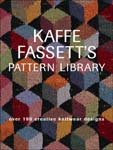
Homes and Antiques, September 2016
Enrich your favourite knitwear by dipping your needles into the palette of painterly knitwear designer, Kaffe Fassett
Article by Kate Taylor
Published in time for Christmas, but intended as a companion for life, this is a new book from the original master of colour and pattern.
Tall and still strikingly handsome, Kaffe Fassett’s looks and his creative energy belie his 65 years. He led the way into his light, bright front room and sat on the floor on a pile of his cushions in the bay window, beneath his collection of lucky Buddhas. He explained to me, ‘Pattern Library’ has taken 3 years to compile. It harks back to my earliest knitting motifs, featuring designs for the Italian fashion house Missoni, Scottish fashion designer Bill Gibb and The Peruvian Connection. Every design in the book is done in basic stocking stitch, so even beginners can jump in and unleash their creativity, choosing colours and making their own personal combinations”.
The book begins with a section on geometric patterns, starting with multi-coloured stripes, which make fabulous blankets and throws. “The first few pages are steps that are easy enough for anybody to follow”, Kaffe said. It moves on through wonderful stars, to crosses, zigzags and 3-D cubes. Later there are colourful photographs of his figurative patterns, from his famous Apples’ design to flamboyant ‘Daisy’ and ceramic vases. I asked him how he managed to put so many colours together in each pattern to such exciting effect. He said, “As you travel you collect up a collage of wonderful colour combinations in your head. When you play with ideas, out it comes, because it is in you”. He added, “But you have to begin to value looking. You don’t just say `that’s pretty’ and pass on, you quickly analyse it”.
In the book, he writes, “For outrageous dancing on the table colour, look at The Simpsons cartoon on TV, circus and bullfighting posters, paintings by Emile Nolde, Matisse, or any of the Fauve school of painters. Or better still, travel to India, Africa or Guatemala and spend time in local markets”.
At the back of the book all the stitch patterns are given as charts, with captions giving hints about Kaffe’s creations. For instance there is a vibrant red, green, grey, purple, black, charcoal, brown, pink, fuchsia, ochre and orange ties, called `Mirage’. The caption explains, “This jazzy pattern was inspired by my passion for kilim rugs. I knitted it on my first trip to India – hence the spicy hot palette”. Since Kaffe was a painter before he became world famous for his knitwear designs, I asked if there was any conflict between the two art forms. “To me it’s all the same – it’s all the manipulation of colour”, he said. “I would like people to have fun with this book. To try lots of things they wouldn’t usually knit by making a big sample blanket or a long scarf and trying patterns out on it. I’m not telling them what colours to use. They have to make choices. Everything is possible; any colour way can be exciting”.
The book helps knitters to do this in a section on using the charts, which explains in a simple and encouraging way how to design your own motifs and how to turn the chart patterns into garments. “You need a maverick streak”, he said. “A woman asked me for a jumper, specifying ‘no purple’. I was knitting it, telling myself `no purple’ but then something happened in my head and I just had to put purple in after all. I delivered it and waited for a reaction. She came back to me saying she absolutely loved it and that I had converted her to purple because of the way in which I’d used it!”. Kaffe’s great enthusiasm comes through, and he suggests that groups of knitters should make blankets of knitted patches. “By crocheting around each contribution you needn’t worry about the various tensions not coming up with a uniform size, just add more border until they equal out. Tassels or fringes could be a luxurious finish to your splendid group effort”. This is what the knitters in his family do for each new baby.
Kaffe said he feels that since the late 70s, England has unleashed an eruption of design talent on the world. Sasha Kagan, Jamie and Jesse Seaton and Susan Duckworth and Kaffe have launched collections, published books and taken part in exhibitions and TV programmes on knitting. “This country is now ripe to host its own celebration of knitting”, he believes. Knitting is therapeutic, because it provides people with an antidote to the stresses of the modern world. It is satisfying, too, he says, “I find that all people who work with their hands are centred people. They tend to be confident and happy to work with themselves”.
‘Kaffe Fassett’s Pattern Library’ should help unleash many people’s creative spirits. Flipping through its pages you can start with colourful rows of stripes and graduate to complex flowers or animal forms. If you change the colours to suit yourself, all the better, according to Kaffe. He said, when he sees one of his patterns in stunning new colours he inwardly celebrates, and if the new colours don’t work, he admires that person’s courage and says to himself, “At least she did it!”
